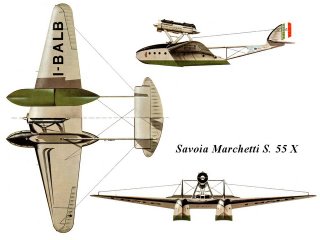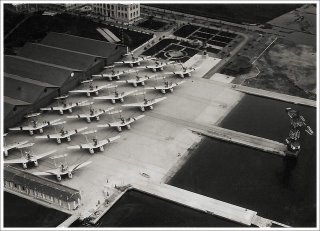SAVOIA-MARCHETTI S-55


Of all the large transport aircraft built during the period between the two world wars, few were more aesthetically appealing than those produced by the Italian firm of Savoia-Marchetti. And of all the Savoia-Marchetti models, none was more aerodynamically sound--or more effective--than the S-55 flying boat. Moreover, the S-55 set records for reliability and endurance that were unsurpassed for its day.
The design of the S-55 was not orthodox by any standards. It had twin hulls in which passengers were carried, while its pilot and copilot occupied an open cockpit in the thick center sections of its high wing. It was powered by two engines mounted one behind the others on a superstructure above the wing and canted sharply at an upward angle. Two wire-braced booms connected the triple-finned tail structure to the twin hulls and wing.
Even though its design was unusual, the Savoia-Marchetti S-55 was a remarkably airworthy craft. In 1926 the S-55 set 14 world records for speed, altitude and distance with a payload. The S-55's greatest successes, however, were its many flights between Europe and the Americas.
One of these flights started on February 13, 1927, more than three months before Charles A.Lindbergh's nonstop solo flight across the North Atlantic from New York to Paris. Italian pilots Francesco de Pinedo and Carlo del Prete took off from Sesto Calende, Italy, in an S-55 christened the Santa Maria and headed west across the South Atlantic. Four months later they arrive back in Italy, having flown nearly 30,000 miles in 193 flying hours and having made just over 50 stops--including Rio de Janeiro, Buenos Aires and New York City.
But the most Spectacular flight of the S-55 took place in 1933--ten years after the airplane was first constructed. On July 1, 1933 General Italo Balbo, the air minister of Italy, led a flight of S-55s from Orbetello, Italy, to the Century of Progress Exposition in Chicago, Illinois, in just over 48 hours. There were 24 S-55s in General Balbo's flight--and they completed the entire flight both over and back in a tight V formation. Even today pilots frequently refer to a large formation of aircraft as a Balbo.


may the force be with you
Copyright © (all star network)








Δεν υπάρχουν σχόλια:
Δημοσίευση σχολίου